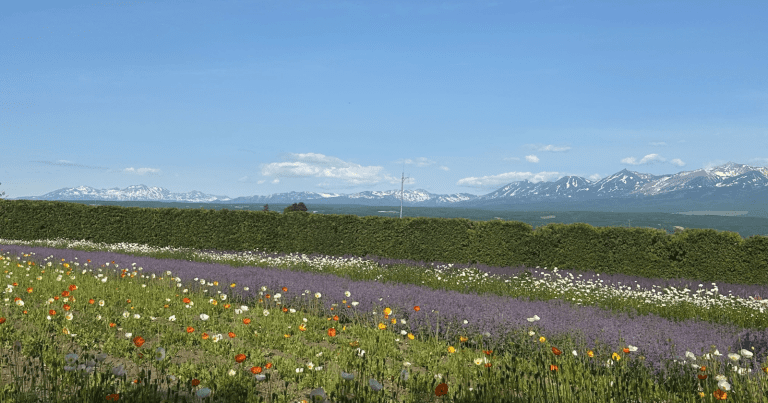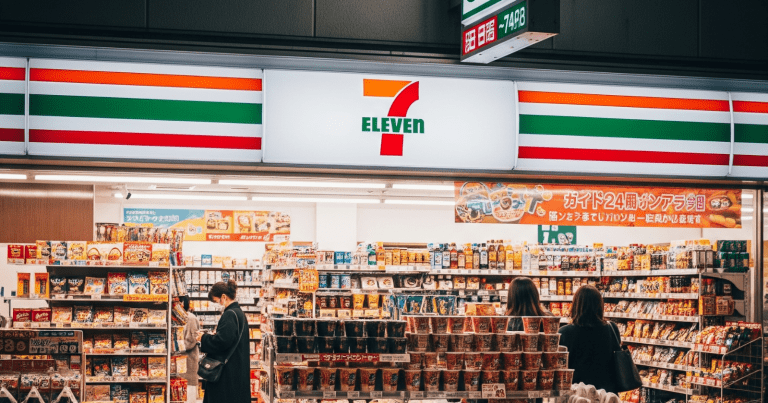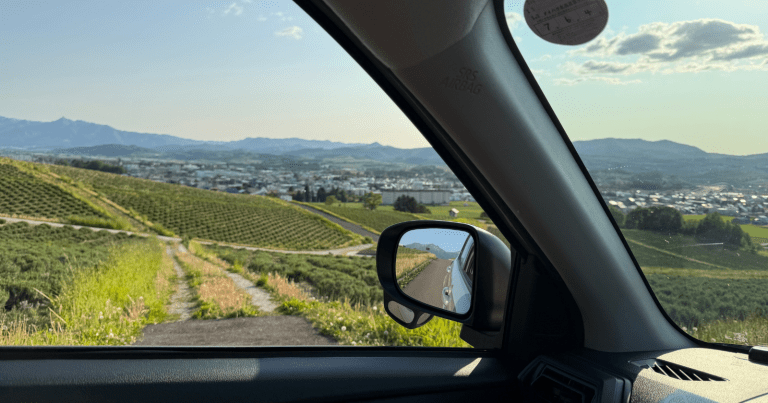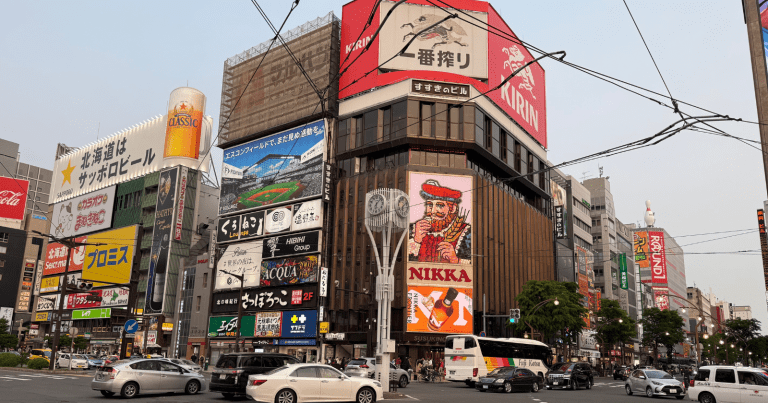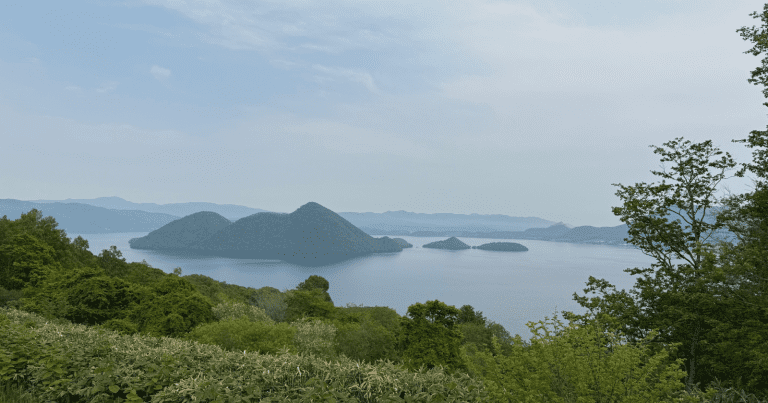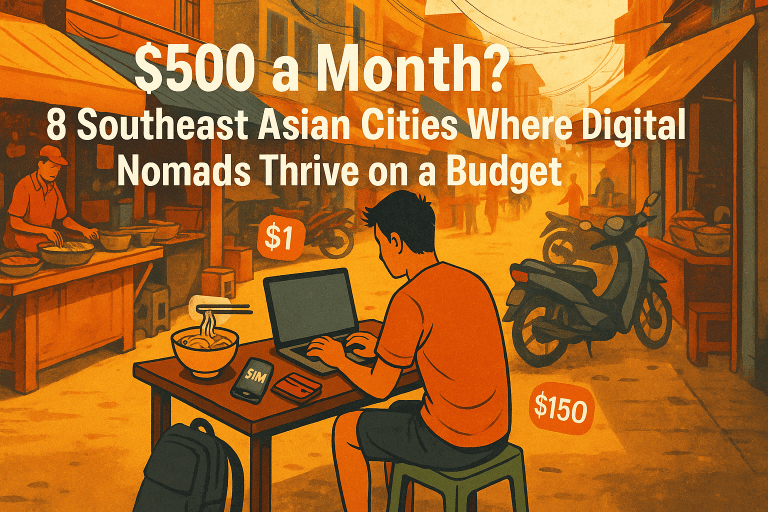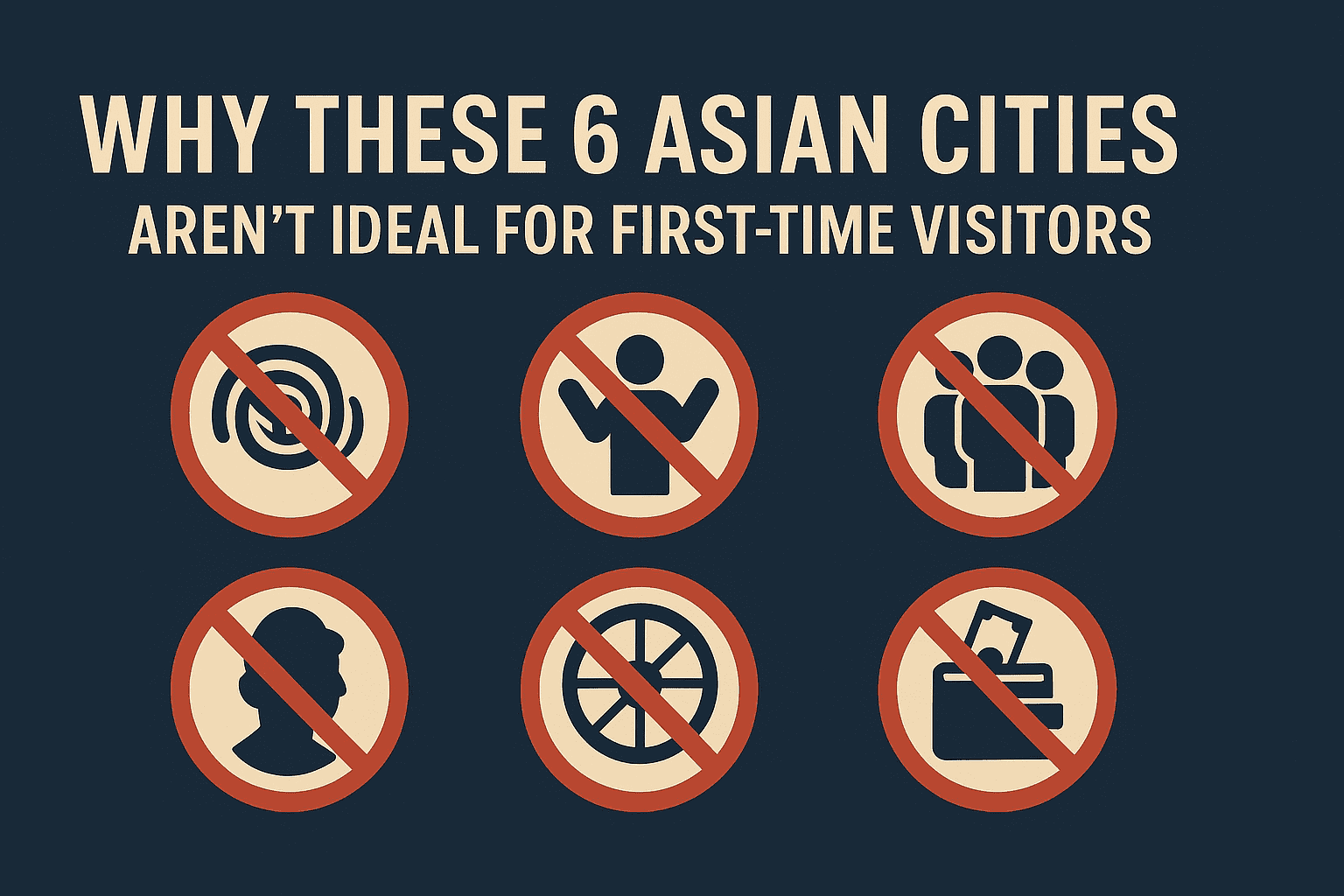
Picking your first destination in Asia is exciting, but make the wrong choice, and your dream trip can quickly turn into a stressful, overwhelming experience. As a seasoned traveler who’s navigated everything from serene islands to bustling mega-cities, I’ve learned that some places demand a level of travel savvy and resilience that first-time visitors simply haven’t built up yet. The goal of savvy travel isn’t just about saving money or finding hidden gems; it’s about making smart decisions that set you up for success and enjoyment. That starts with choosing the right starting point.
You might see incredible photos or hear whispers of adventure from these places, but for a first-time visitor to Asia, diving headfirst into certain metropolises can feel like being thrown into the deep end without a life jacket. Instead of easing into the experience, you could find yourself grappling with intense culture shock, navigating complex and potentially intimidating transport systems, facing significant language barriers that hinder basic interactions, or constantly being on guard due to safety concerns.
This isn’t to say these cities aren’t worth visiting – far from it! They are vibrant, fascinating places teeming with life, history, and incredible experiences. But they require a different mindset, a bit more preparation, and perhaps a few successful trips under your belt to truly appreciate them without being overwhelmed. This article will tell you why these six Asian cities, while amazing, might not be the ideal launchpad for your first Asian adventure, and help you understand the specific challenges they present so you can make a more informed decision for your initial journey. Consider this your friendly heads-up from someone who’s been there.
Why Some Cities Demand More Savvy
When you’re new to a continent as vast and diverse as Asia, your first destination should ideally offer a relatively gentle introduction. You want places with well-established tourist infrastructure, where English is reasonably understood in key areas, where transport is navigable, and where common scams are less prevalent or easier to spot. Many first-time travelers choose better starting points that allow them to build confidence before tackling more complex environments.
The cities we’ll discuss often present challenges that can quickly erode a first-timer’s confidence. These challenges aren’t insurmountable for experienced travelers, but for someone fresh off the plane, they can feel daunting. They range from the sheer, relentless energy and density of the urban environment to navigating layers of cultural norms that are vastly different from Western ones, and dealing with practicalities like intense traffic or potential safety risks that require constant vigilance.
It’s all about the learning curve. In some cities, that curve is steep and unforgiving. Getting around might involve understanding complex bus routes with signage only in the local language, haggling aggressively for every taxi ride, or simply trying to cross the street in a never-ending flow of traffic. Language barriers can turn simple tasks like ordering food or asking for directions into frustrating charades. Safety, while often a concern exaggerated by media, requires a heightened sense of awareness in certain areas, which can be exhausting when you’re already dealing with sensory overload. Instead of focusing on the wonders around you, you might spend most of your energy simply surviving.
Understanding these potential hurdles upfront is key to dodging chaos and making a smart choice for your inaugural trip. While many easier cities exist with well-trodden backpacker trails and infrastructure designed for visitors, the following six require a bit more armor in your travel toolkit.
“By failing to prepare, you are preparing to fail.”
This quote might sound stern, but it holds wisdom for travel. While you can’t prepare for *everything*, understanding the specific challenges a destination presents allows you to either prepare adequately or choose a more suitable starting point. For a first trip to Asia, opting for a city that requires less ‘failure management’ upfront is a solid strategy.

The Six Cities (And Why They’re Not First-Timer Friendly)
Let’s break down why these specific cities, for all their undeniable allure, might be better appreciated on a subsequent visit:
1. Mumbai, India
Mumbai is an experience unlike any other – a pulsating, relentless, vibrant behemoth. It’s the financial and entertainment capital of India, incredibly diverse, and absolutely fascinating. However, for a first-timer, it can be overwhelmingly intense. The sheer density of people, the cacophony of sounds, the stark contrast between wealth and poverty, and the sometimes aggressive pace of life can be a lot to process.
Navigating Mumbai’s local trains, while an authentic experience, is famously challenging, especially during rush hour. Getting around requires understanding different transport modes and often involves navigating crowded, chaotic streets. While many people speak English, navigating daily interactions, bargaining in markets, and simply understanding the local rhythm takes time and patience. Safety requires a heightened sense of awareness, particularly for solo female travelers or in crowded public spaces. The cultural differences are profound and require significant adaptation, which can be exhausting when you’re also battling jet lag and sensory overload.
2. Ho Chi Minh City, Vietnam
HCMC, or Saigon as many still call it, is a dynamic city hurtling into the future while holding onto its past. It’s famous for its history, incredible street food, and non-stop energy. What makes it challenging for first-timers? Primarily, the traffic. Crossing the street is an art form that involves stepping out into a river of scooters and hoping they flow around you. It’s terrifying and exhilarating, but requires a leap of faith and quick reflexes that can be unnerving initially.
Beyond traffic, HCMC has a reputation for scams targeting tourists – from aggressive touts to inflated taxi fares. While common in many tourist hotspots, they can feel particularly relentless here and require a level of assertiveness and vigilance that first-time travelers might not possess. The city is vast, and while Grab (ride-hailing) makes transport easier, navigating on foot in the heat and humidity can be tiring. While English is spoken in tourist areas, venturing off the beaten path can quickly present language barriers. The sheer intensity and constant buzz can be exhilarating but also draining for someone not used to it.
3. Jakarta, Indonesia
As the capital of Indonesia, Jakarta is a sprawling mega-city that is home to millions. It’s a melting pot of cultures and a hub of commerce. However, as a tourist destination, it presents significant challenges for first-timers. Traffic is legendary – commutes can take hours, making getting around to see different parts of the city a major undertaking. The public transport system is improving but not as comprehensive or easy to navigate as in some other Asian capitals.
Jakarta is vast and lacks a single, easily walkable tourist center like some other cities. Attractions are spread out, requiring significant travel time between them. While there are pockets where English is spoken, outside of business and major tourist areas, communication can be difficult. Safety requires caution, especially at night in certain areas, and petty crime can be an issue. Compared to Bali or Yogyakarta, Jakarta is less geared towards international tourism infrastructure, making independent navigation feel less intuitive. It’s a city you tackle when you’re comfortable with complex urban environments and long transit times.
4. Manila, Philippines
Manila is a city of contrasts – historic forts stand near modern skyscrapers, and jeepneys navigate streets alongside private cars. It’s the heart of the Philippines, but like Jakarta, it’s a sprawling, congested metropolis that can be challenging for first-time visitors. Traffic is notoriously bad, making getting between its distinct districts (like Intramuros, Makati, or Bonifacio Global City) time-consuming and frustrating.
Safety is a consideration in certain areas of Manila, requiring travelers to be aware of their surroundings, especially after dark. While English is widely spoken in the Philippines, navigating local transport (jeepneys, LRT/MRT) and understanding the nuances of different neighborhoods can still be tricky for a newcomer. The city can feel overwhelming due to its size and density, and finding authentic local experiences might require more effort than in more compact or tourist-friendly destinations. Exploring Filipino food or history here is rewarding, but reaching those spots through the traffic is the first hurdle.
5. Shanghai, China
Shanghai is a dazzling, futuristic city that showcases China’s rapid modernization. It’s cosmopolitan, clean, and incredibly efficient in many ways. So why might it be challenging for a first-timer? Firstly, the scale. Shanghai is immense, and while its metro system is world-class, the sheer number of lines and stations can be initially daunting. The language barrier, while less pronounced than in some other Chinese cities in the main tourist and business areas, is still significant once you step away from these hubs. Most apps and websites are in Chinese, which brings us to another major point: the ‘Great Firewall’.
Accessing sites like Google, Facebook, Instagram, and even many Western news outlets requires a reliable VPN, which can be a technical hurdle first-timers aren’t prepared for. Without it, basic planning, communication, and navigation (like using Google Maps) become much harder. While incredibly modern, the cultural norms are distinct and require observation. It can sometimes feel less like a traditional ‘Asian’ cultural immersion and more like navigating a hyper-modern global city with unique local characteristics, which might not be what some first-timers are seeking for their initial taste of the continent.
“The city, however, does not tell you its past, but contains it like the lines of a hand, written in the corners of the streets, the gratings of the windows, the banisters of the staircases, the antennae of the lightning rods, the poles of the flags, every segment of scratched or chipped wall, bound in turn to every scratch, every chip, every dent.”
– Italo Calvino, Invisible Cities
Calvino’s description captures the layered complexity of cities. Some cities, like Shanghai or Mumbai, have so many hidden narratives and practical complexities embedded in their structure that reading them requires experience and a willingness to dig deeper than a first-time, potentially overwhelmed, visitor might be able to manage.
6. Dhaka, Bangladesh
Dhaka is one of the most densely populated cities in the world and an experience of truly epic proportions. It’s vibrant, chaotic, and profoundly different. For a first-time visitor, especially one arriving from a Western country, the culture shock can be intense. The traffic is notoriously gridlocked, air pollution is significant, and the infrastructure can feel overwhelming and difficult to navigate independently.
Finding people who speak English outside of tourist-focused areas (which are few compared to other cities) is challenging, making basic communication difficult. Safety requires constant vigilance, and harassment, while not always malicious, can be persistent. The sheer volume of sensory input – sounds, smells, sights – is unlike almost anywhere else and can be exhausting. Dhaka is a city that demands patience, adaptability, and a high tolerance for chaos. It offers incredibly rich cultural experiences and genuine interactions once you break through, but it’s not a place for easing into travel. Understanding local cultural nuances is particularly vital here.
Anecdote: The Manila Commute
I remember my first time trying to navigate Manila using only public transport like the LRT and then transferring to a jeepney. I thought I had it figured out, but between confusing station signs, figuring out the correct jeepney route (they don’t have numbers, just destinations scrawled on the side), and dealing with the intense heat and crowds, I got completely turned around miles from where I intended to be. It took asking about ten different people, switching jeepneys multiple times, and a good dose of frustrated wandering before I finally made it. An experienced traveler would likely take it in stride, maybe switch to a ride-hailing app immediately. But as a younger, less confident traveler, that feeling of being lost and slightly helpless in such a chaotic environment was pretty disheartening and ate up a huge chunk of my day. It made me appreciate how much easier it is when transport systems are clearly signed and language isn’t a barrier – something you need when you’re still finding your travel feet.
Choosing Your Ideal First Step
So, if these cities present such challenges, where *should* you go for your first Asian adventure? Focus on cities known for their accessibility, tourist-friendly infrastructure, relatively easy navigation, and areas where English is commonly spoken. Think places like Kuala Lumpur, Singapore, Bangkok, Chiang Mai, Kyoto, or Seoul. These cities offer incredible cultural experiences, delicious food, and efficient transport, allowing you to focus on soaking it all in rather than battling logistical nightmares.
When researching, look for resources that specifically discuss ease of transport, safety ratings, English proficiency indexes (like the EF EPI mentioned earlier), and traveler reviews focusing on navigability for first-timers. Reliable travel blogs, forums like Reddit’s r/travel or r/backpacking, and guidebooks often provide insights into a city’s ‘ease of use’. Don’t just look at the attractions; look at the practicalities of getting to them and moving around the city.
Start with cities where the culture shock is present but manageable, where getting lost isn’t a disaster but a minor detour, and where you can easily communicate your basic needs. Build your confidence by mastering simple things like using public transport, trying street food safely, and interacting with locals in a less pressurized environment. This foundation will make tackling more challenging cities later not only possible but genuinely enjoyable, as you’ll have the skills and confidence to navigate their complexities and truly appreciate their unique character.
Conclusion: Start Smart, Travel Further
Your first trip to Asia should be an inspiring adventure, not a trial by fire. While Mumbai, Ho Chi Minh City, Jakarta, Manila, Shanghai, and Dhaka are phenomenal cities with so much to offer, their intensity, logistical challenges, and potential safety concerns can be overwhelming for first-time visitors still finding their travel rhythm. Understanding why they aren’t ideal starting points allows you to make a smart decision and choose a destination that offers a smoother, more comfortable introduction to the wonders of Asia.
Remember, travel is a skill that you build over time. Start with an easier ‘level’ to hone your skills and gain confidence. You can tackle the exhilarating chaos of Mumbai, the intense traffic of HCMC, the sprawl of Jakarta and Manila, the futuristic scale of Shanghai, or the raw energy of Dhaka on a later trip, equipped with the experience and savvy needed to truly thrive. Choose your first city wisely, and you’ll unlock a lifetime of incredible Asian adventures.


